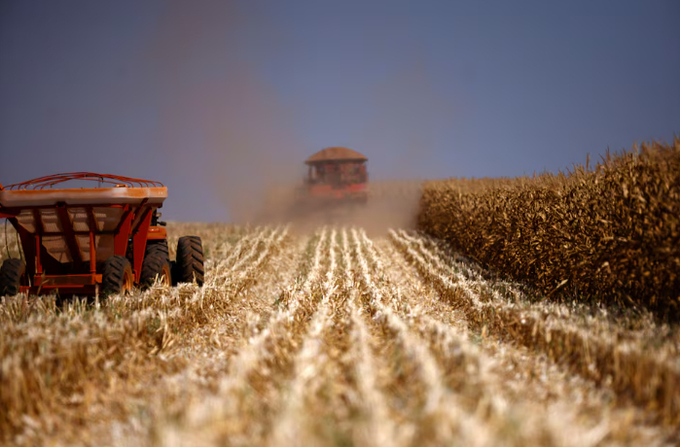November 28, 2025 | 01:29 GMT +7
November 28, 2025 | 01:29 GMT +7
Hotline: 0913.378.918
November 28, 2025 | 01:29 GMT +7
Hotline: 0913.378.918

A combine harvester is seen as it harvests corns at a farm near Brasilia, Brazil August 22, 2023.
That same controversy may be brewing for the country’s corn crop, especially with unfavorable conditions potentially on tap for Brazil’s top production state.
Less attention has been paid to the corn estimates versus those for soybeans in recent weeks because Brazil’s heavily exported second corn crop planting efforts are just now concluding, though more than half of the soybeans have been harvested.
The U.S. Department of Agriculture last week trimmed Brazil’s 2023-24 soybean harvest to 155 million metric tons from 156 million estimated in February, a much smaller cut than expected. Brazil’s statistics body, Conab, on Tuesday reduced its peg to 146.9 million tons from 149.4 million in February.
USDA’s and Conab’s soy crop disparity widened in February with USDA 6.6 million tons (4.4%) higher than Conab. That margin increased to 8.1 million tons (5.5%) this month, equivalent to 300 million bushels. The agencies differed by less than 2 million tons in January.
In the previous eight seasons, the largest March differential between these forecasts was five years ago, when USDA was 2.7% higher than Conab.
The year-on-year implications are more consistent, suggesting some overlapping assumptions. USDA sees Brazil’s 2023-24 bean harvest down 4.3% on the year while Conab’s figures suggest a 5% decline.
However, the latest estimate discrepancy, roughly equal to the projected 2023-24 U.S. soy carryout, must be solved somewhere on the balance sheet, especially since Brazil carries relatively low year-end bean stocks.
USDA and Conab hold similar views of Brazil’s 2023-24 soy carryout, both between 2 million and 3 million tons on a local marketing-year basis (February-January). USDA gets to that number with an export estimate some 6.7 million tons above Conab’s.
Perhaps Brazil will export these extra beans to top buyer China, as USDA’s 2023-24 Chinese imports stand at 105 million tons versus 102 million estimated last month and 104.5 million last year. USDA this month hiked the current and prior Chinese demand estimates after an in-depth data review.
But China on Friday kept its 2023-24 soy import forecast unchanged on the month at 97.25 million tons, down fractionally on the year. Additionally, total Chinese soy imports through February, the fifth month of 2023-24, are down 1% from last year to a five-year low for the period.
USDA predicts the full 2023-24 Brazilian corn harvest at 124 million tons, well above Conab’s view of 112.75 million. This 10% margin is the largest for March in at least eight years, though USDA was 8% higher than Conab in March 2018, and Conab was ultimately closer to the final.
USDA’s harvested corn area sits 7.5% (3.8 million acres) above Conab’s planted area, implying an even larger difference in the planting estimates. Conab has trimmed its area 4% since its initial forecast as grain prices have slid in recent months.
However, USDA has made relatively substantial reductions to its Brazil corn estimate, which has fallen 4% since the initial peg last May. That is the largest percentage decline within that time frame in 14 years and the largest by volume in 15 years.
It is still early for either agency to capture any big downward moves, if relevant, in Brazil’s corn crop. Both the 2015-16 and 2020-21 harvests landed about 20% lower than USDA or Conab had predicted in March as poor weather emerged in the following months.
The 2015-16 corn harvest was notoriously terrible for top grower Mato Grosso amid insufficient rains. The state had moisture deficit issues with soybeans this year, and the same could happen with corn.
Midday weather models on Wednesday turned drier for Mato Grosso following the driest January-February in nine years. Observed March rainfall plus the two-week forecast suggests chances for the driest March in multiple decades.
(RT)

(VAN) A new study reveals how the simultaneous effects of ocean acidification, salinity and loss of oxygen are making the world more fragile.

(VAN) Hopes are growing that the creation of the first 3D turkey gut model could be a turning point in the battle against the virulent blackhead disease.

(VAN) Tyson, America’s biggest meat supplier, plans to shutter one of its largest beef processing plants as the industry continues to struggle with low cattle supplies and political pressure from Washington.

(VAN) New FAO study shows how digital solutions are empowering farmers and fishers to prevent losses and build resilient agrifood systems.

(VAN) Brazil's COP30 presidency pushed through a compromise climate deal on Saturday that would boost finance for poor nations coping with global warming but that omitted any mention of the fossil fuels driving it.

(VAN) Poultry farmers in the UK have been warned that they could face one of the worst winters yet for bird flu.

(VAN) Prices of main-crop paddy have risen sharply, with jasmine rice hitting 16,100 baht per tonne — the highest level in years.